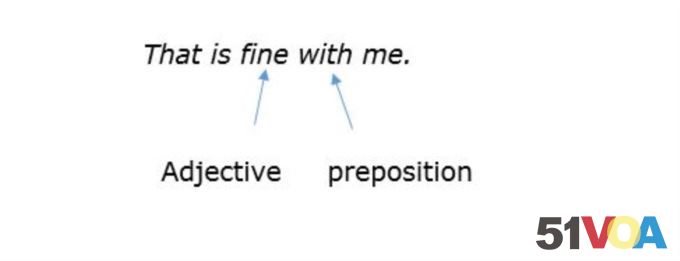21 September, 2017
The 2007 film No Country for Old Men tells the story of a lawman in West Texas. Actor Tommy Lee Jones played the part of the lawman. If you saw the movie, you might remember when he spoke these lines:
"The crime you see now, it's hard to even take its measure. It's not that I'm afraid of it. I always knew you had to be willing to die to even do this job."
Our report today is not about crime.
Instead, it is about one grammatical structure you just heard: an adjective + preposition combination. Jones used it when he said, "afraid of."
What exactly are these structures? We will tell you, but first we have to give some definitions.
Adjective + preposition in conversation
Adjectives are words that describe nouns.
You will hear English speakers use adjectives in front of nouns or after non-action verbs. Non-action verbs include words like "be," "seem," "become," and so on.*
Here are two examples:
- My neighbors have a big dog.
- The dog is sick today.
In the first example, the adjective "big" comes before the noun "dog." In the second example, the adjective "sick" comes after the verb "be" – a non-action verb.
Susan Conrad and Douglas Biber are language experts. They note that when English speakers use adjectives before a noun, they almost never use a preposition. However, when speakers use adjectives after a non-action verb, they often use a preposition.
Here are two examples:
- We had a fine day!
- That is fine with me.

In the first example, the adjective "fine" comes before the noun "day." There is no preposition after "fine."
In the second example, the adjective "fine" comes after the non-action verb "be." The adjective "fine" is followed by a preposition: with.
"Fine with" is one example of an adjective and preposition combination. It means good, acceptable, or satisfactory.
In everyday situations, speakers use many adjective and preposition combinations. These adjective and preposition combinations have specific meanings.
There are many possible adjective and preposition combinations. We cannot give you all of them. However, we can tell you about three of the most common ones you will hear when Americans are talking.
These include adjective + of, adjective + for, and adjective + with
Adj. + of
The first common structure you will hear in everyday speech is adjective + of.
Speakers often use adjectives such as "afraid," "tired," or "sick" with the preposition "of."
For example, Americans often use "tired of" and "sick of" to show restlessness or a lack of interest in something. Usually, they use this expression when they feel they have had, seen, or done too much of something.
Bad students, for example, might say the following words:
I'm tired of school.
Yeah! Me, too. And I'm sick of homework.
When the students say "tired of" or "sick of", they do not mean that they are tired or sick. Instead, they mean that they have spent too much time in class.
We hope you do not feel that way about school!
Adj. + for
A second common structure you might hear in everyday speech is adjective + for.
Speakers often use the adjectives "good," "great," or "ready" with the preposition "for."
Doctors, for example, might say, "Vegetables are good for your health." Some people might even say, "Vegetables are great for your health."
In both cases, the adjective + for structure means not causing harm or causing something desired. The main difference is that "great" has a stronger meaning than "good."
Adj. + with
A final common structure is the adjective + with combination.
Examples include the expressions "fine with," "happy with," and "wrong with."
You heard one of these earlier:
That is fine with me.
This is a casual way of showing approval. How could you use it in an everyday situation?
Here is an example. At a café, you might hear the following words:
Waitress: I'm sorry sir, but we do not have cream. Would you like milk instead?
Customer: Sure, that is fine with me!
In the example, the waitress gives bad news: the café does not have cream. Her customer gives an agreeable response by saying "that is fine with me." Speakers use those words in many situations – at stores, restaurants, hotels and so on.
What can you do?
The next time you are watching a movie or reading a book in English, try to look for examples of adjective + a preposition. Do the speakers use similar or different adjective and preposition combinations?
Learning adjective + preposition combinations can be difficult. But if you put in hard work, you will be happy with the results.
I'm John Russell.
And I'm Jill Robbins.
John Russell wrote this story of VOA Learning English. George Grow was the editor.
* These are also called linking verbs. The adjective acts as the subject complement – it is describing the subject.
_________________________________________
Words in the Story
preposition – n. grammar : a word or group of words that is used with a noun, pronoun, or noun phrase to show direction, location, or time, or to introduce an object
cream – n. the thick part of milk that rises to the top; the part of milk that contains fat
response – n. a reaction or answer
casual – adj. not planned; done without much thought or effort
specific – adj. special; exactly presented or stated
grammatical – adj. of or related to the rules of language